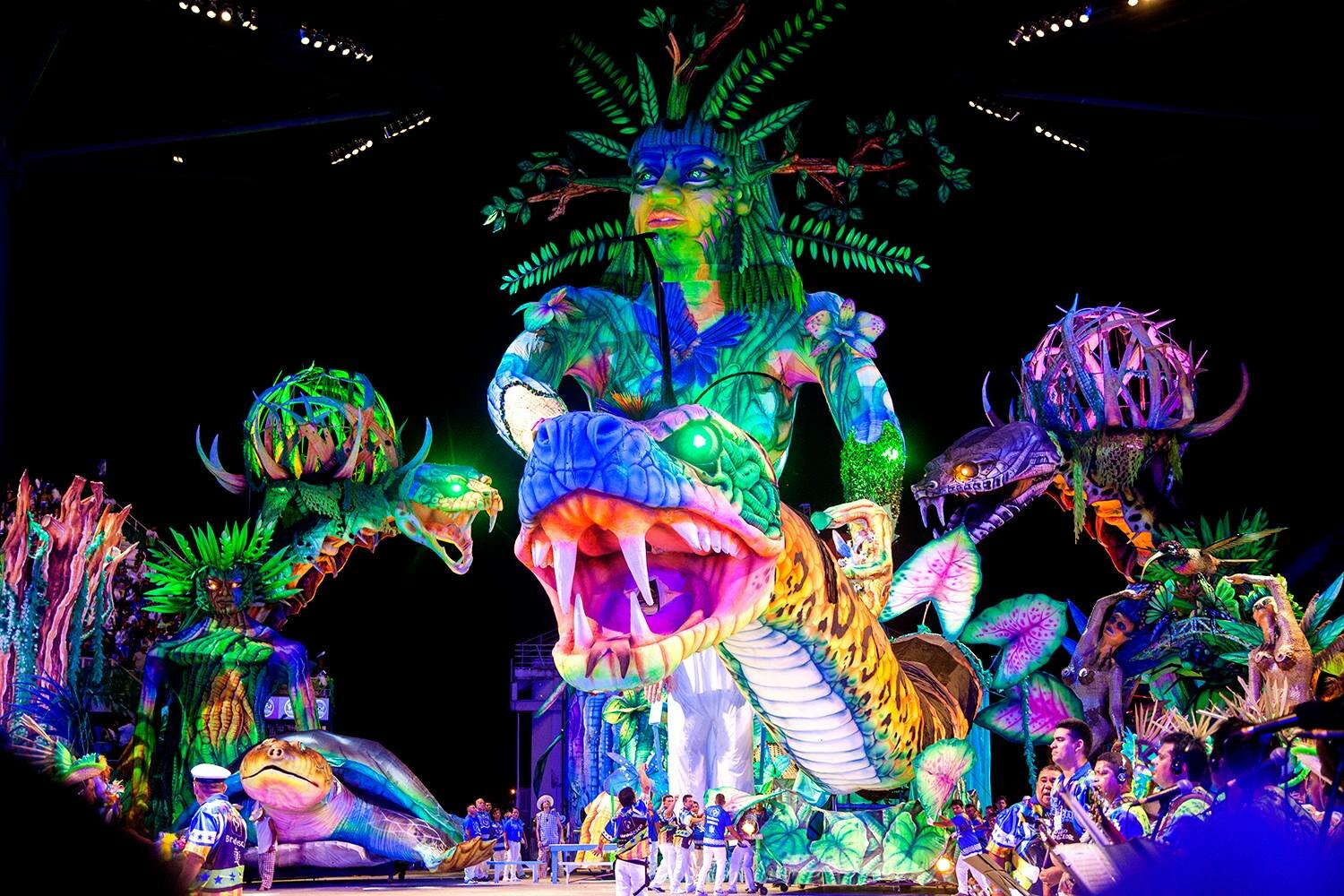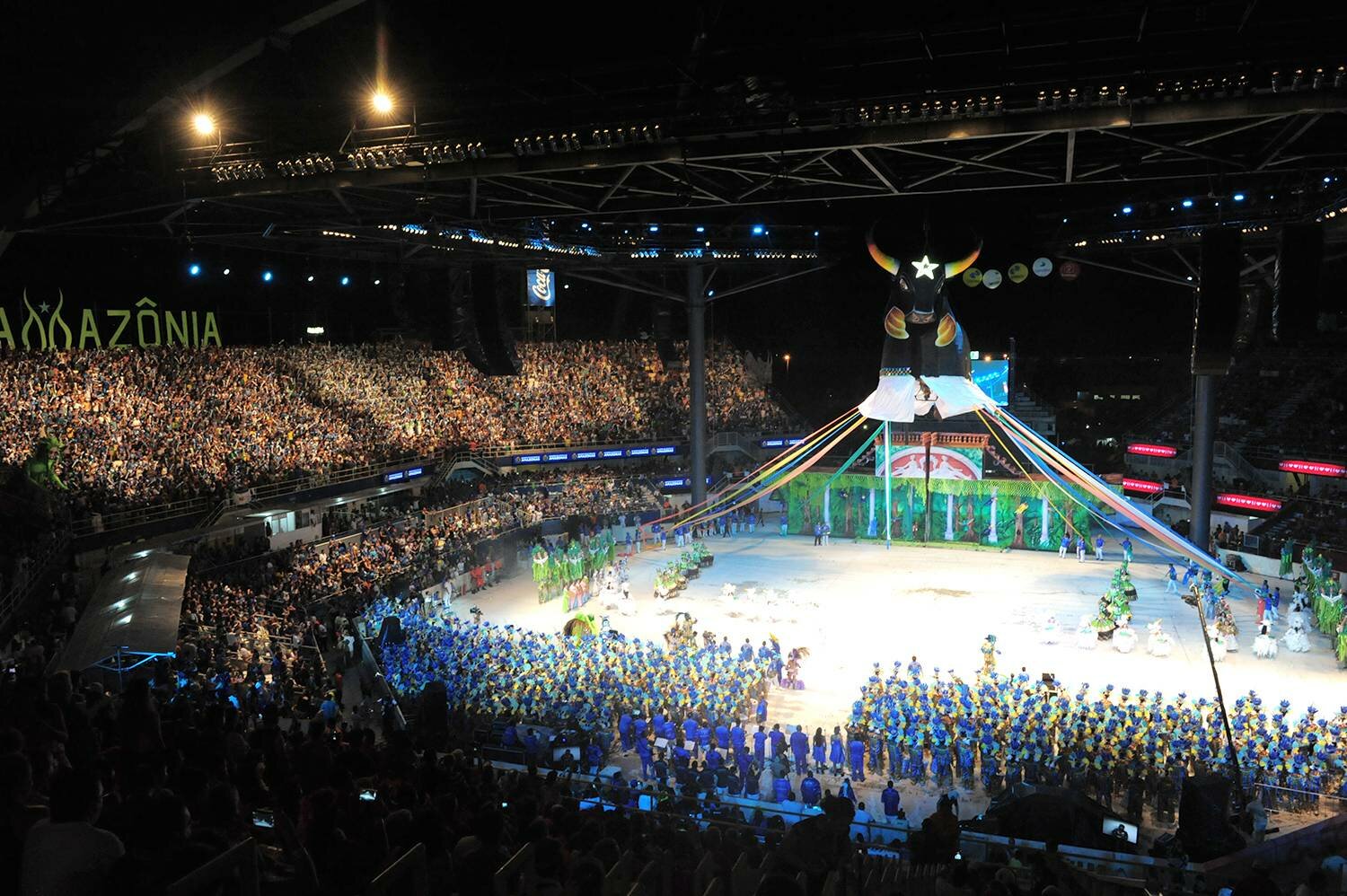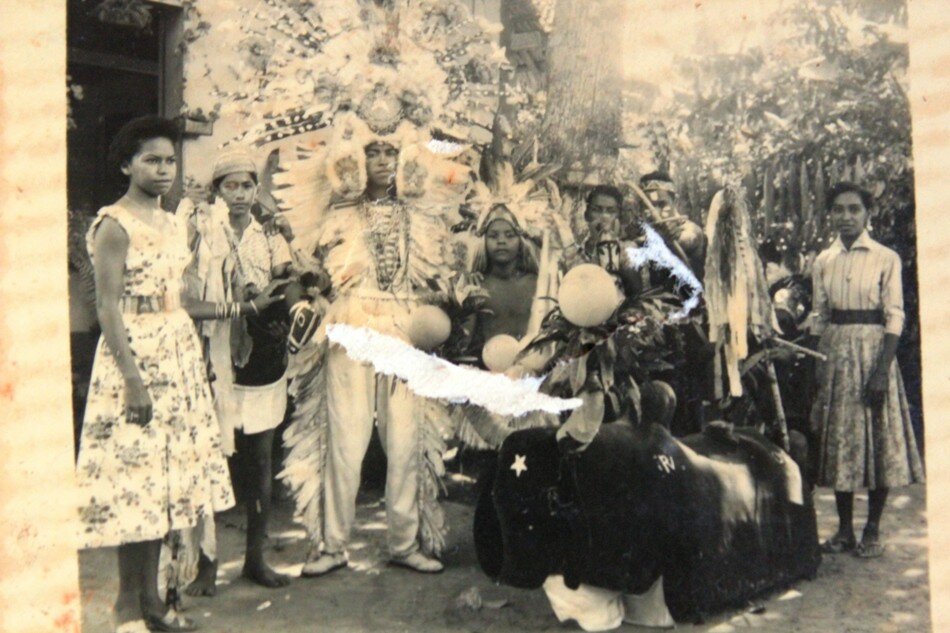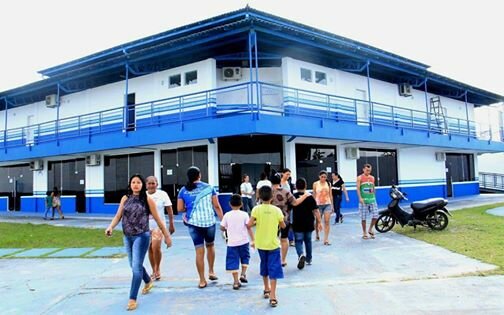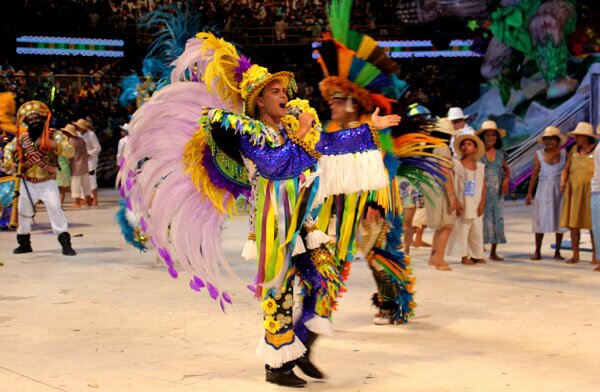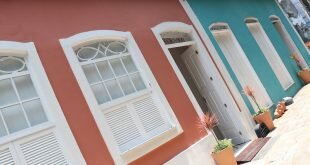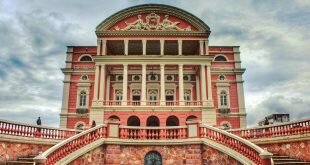The Boi Caprichoso defends the colors blue and white. Its symbol is a blue star, which it displays on its forehead. It is also known as "O Boi de Parintins" and "Touro Negro da América".
The Parintins bull is the popular, spectacular, and creative auto, the reinvention of the myth, the legend of the enchanted bull that dies and comes back to life, rediscovering the Amazonian culture. He travels through the forest and its corners, incorporates the mythical and regional legendary universe, besides valuing rituals, tribal celebrations, customs, and popular tradition. To its repertoire are joined the defense of the forest, the strength of the simple and solidary people, and the essence of life in the sustainable Amazon.
Life sounds with the Marujada, summarizing the love that pulsates in the hearts of the blue-skinned people. In June there is a party and Parintins reveals itself in verses, poetry, and singing. The toy bull seduces the crowds and frames with a broad smile the face of each caboclo who wears blue and white, the colors that rock the popular party of Boi Caprichoso. He moves his head, dances, plays, is loved, arouses passions, translates the purest and simplest emotion that is born in the chest, invades the soul, brings an infinite joy that does not pass and makes you feel an intense fire that spreads over the heart. The velvet ox bewitches, ravishes. It recreates our love, our life, our history, infecting the world with the rhythm of the drums, with dance, with magic, with tradition and poetry. Seduction, fascination, enchantment. A storm of ideas, a granary of creativity, an explosion of feelings, adrenaline that shoots at the touch of the drum, shaking the chest, the earth, life. Pure magic, pure energy, joy, songs, melody. It is Caprichoso, to feel, to translate, to thrill, to play, and to fall in love.
A centennial passion
Founded in 1913, by the hands of families from the Northeast of Brazil who put down roots here and, until today, play and participate in the legacy of their ancestors. The game was born in the backyards of the wooden houses, under the shade of leafy mango and chestnut trees. Surrounded by mysteries and by the people of the forest, it didn't take long for a shaman to be responsible for the resurrection of the most beloved ox of the farm.
The verses of greeting and praise, which sounded strong in the voices of Cid and Gonzaga, with the appearance of the opposite, soon turned into strong challenges. The fuse was lit for the rivalry between the blues and the outsiders! People passed as they always do, but our little ox didn't, he was just welcomed by his new owner, a new family that traditionally became the guardians of the ox, responsible for organizing the outings of the ox in the streets of Parintins. They were carpenters, fishermen, hunters, caboclos, residents of the riverside neighborhood called Francesa, of another called Palmares, of Aninga, of the Center, of all corners of Parintins, that is why it is Boi de Parintins, of all Parintins!
In 1965, the first folkloric festival of the city. Created by the Catholic Athletic Youth, to help reform the cathedral. In 1966 the bulls were invited, and year after year, we participated in the festival, helping to build the most beautiful temple in the city, which is why it is such a strong symbol, so present in our presentations. It can be said then, that it is a festival born from the caboclo's faith, where an ox born and sustained by the belief, by the strength and by the creativity of the capricious caboclos is present. There is life in this cloth toy, yes, there is life, because there is love and passion. It is a passion that has overcome the limits of time, from the nostalgia of the taboos to the strength of the arena, the Caprichoso Ox is alive and eternal in our feelings, a centennial passion.
The legacy of a blue people
The social project of the Boi-Bumbá Caprichoso Foundation, called 'Brother Miguel de Pascale School of Arts', defines itself as a mark of social inclusion and citizenship, involving children, teenagers, and young people from 8 to 20 years old who exercise and develop their intellectual and artistic potential in art workshops, giving back to the community and to the party itself.
The school, founded in 1998, has the privilege of having revealed more than 5,500 new artists that can be seen in the sheds, in the Art Council, in dance, music, and in all the segments where the pioneering mark was planted.
The Boi Caprichoso renews the future of our festival in each one of the hundreds of children in our project.
Individual Items
Host, Master of Ceremonies, Spokesman. Edmundo Oran lives up to the well-known phrase "Since I was a child I have played with Caprichoso". Oran took his first steps in the "Irmão Miguel de Pascalle" Art School, in drawing, keyboard, and singing workshops, until he took part in the tuxauas and costumes workshops which were annexed to the "Escolinha do Caprichoso". In 1997, still as a child, he performed in Caprichoso's Tarde Alegre Infantil (Children's Afternoon), and was a watchman for the helmets and tuxauas in the Bumbódromo, until he was invited to join the Parintins Singing Band in 2003.
In Caprichoso, Edmundo Oran has already been a marujeiro, backing vocal, ringmaster of the official rehearsals, composer, and substitute of the items presenter, ringmaster, and master of the bull. In the arena of the Bumbódromo, he has already been the crowd's animator and caller. His talent with voice and music was recognized in the toada festivals in Parintins, where he won awards as revelation interpreter and best interpreter. In addition, he has experience in presenting shows for tourists, held annually during the high season of transatlantic ships in Parintins. Edmundo Oran gathers experiences in festivals inside and outside Amazonas, either as a presenter or interpreter. But the biggest responsibility came in 2015, when he was invited to take over the item number 03, Amo do Boi. His talent and good acceptance of the blue and white crowd made it so that from the 2017 Folk Festival, Oran is the new Presenter of Boi Caprichoso.
These are merits for scoring: Mastery of arena and audience, verbal fluency, charisma, impostation without interference or intervention that makes it difficult to hear or understand the voice performance, diction, cheerfulness, constant attention in the development of the theme
Differentials and comparisons: Costume and meaning, charisma, voice, resourcefulness, animation.
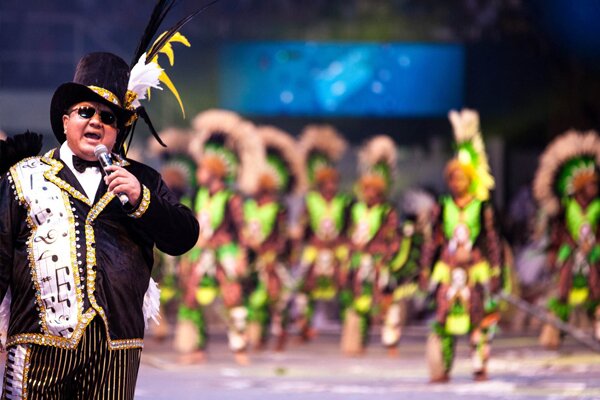 DAVID ASSAYAG - Item 2 - Toada Singer
DAVID ASSAYAG - Item 2 - Toada Singer
The central pillar of the show, his voice is the thread that runs through the development of the theme. The singer David Assayag Neto has established himself as the "Emperor of the Forest" in Boi Caprichoso. Owner of an unmistakable timbre, the Levantador de Toadas reaffirms what the toada Sensibilidade says, because his voice conveys his gift for moving the azulado fans and even the opposing bull's fans. Recognized by the Ministry of Culture as one of the commendations of the Brazilian Popular Culture, he arrives at his 10th year defending the colors of the Touro Negro da América. His experience and talent have already made him share the stage with great talents of Brazilian music such as Fafá de Belém, Elymar Santos, Carlinhos Brown, Banda Calypso, among other artists known on the national scene.
The poor boy, born and raised in the Caprichoso redoubt, grew up and won the world. The "Caboclo Cantador", blessed by Our Lady of Carmel, overflows love in his poems and the certainty that he has sung all his life and will sing all his life. Assayag has become a phenomenon of Amazonian music and a talent that makes the Parintins Folkloric Festival proud. His life was marked by the greatest example of overcoming, the accident that caused him to lose his sight. But like every Parintinense, who finds the strength to overcome difficulties, David overcame all adversities and became the Levantador de Toadas do Boi-Bumbá Caprichoso. Like the legendary bird Uirapuru, every time when David Assayag sings, the forest mutes to hear its minstrel.
These are merits for scoring: Tuning, diction, timbre and singing technique.
Differentials and comparisons: Tuning, vocal range, diction, timbre.
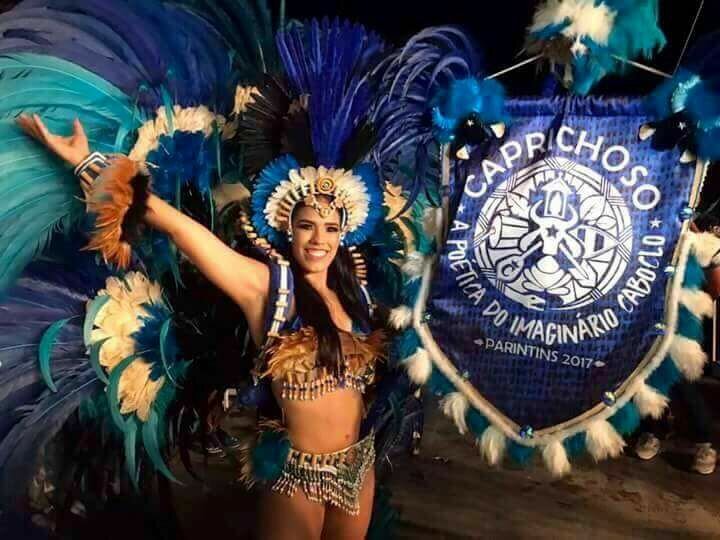 MARCELA MARIALVA - Item 5 - Standard-bearer
MARCELA MARIALVA - Item 5 - Standard-bearer
Symbol of the ox in motion. In many folklore celebrations there is a standard that represents the foundation, symbol, and annual presence of folkloric associations throughout Brazil. In Parintins it is no different, this item is the Porta Estandarte and who conducts it needs to conduct it with dignity, strength and vigor.
These are merits for scoring: Ballet, claw, resourcefulness, sympathy, elegance and joy.
Differentials and comparisons: Costume, banner, lightness, grace, synchrony of movements between the ballet and the banner.
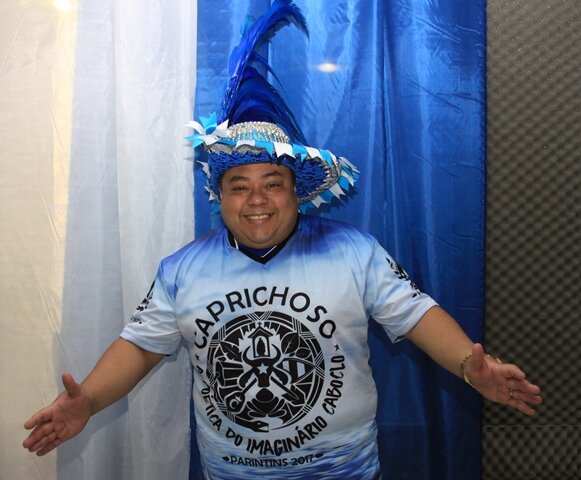 PRINCE OF BOI - Item 6 - Master of the Ox
PRINCE OF BOI - Item 6 - Master of the Ox
The owner of the farm, minstrel who draws verses within the fundamentals of the night. Professional singer and public servant, Herland de Souza Pena, known under the stage name Prince do Caprichoso, has three years of experience in the item Amo do Boi, from 2007 to 2009, with two wins, at the Parintins Folkloric Festival. He started his artistic career and made history in local bands in Manaus. His talent for singing toadas de boi-bumbá gained notoriety in the band "Tucandeira", created by the artist Juarez Lima. For 19 years, Prince do Boi has been successful, interpreting toadas do Caprichoso. Because of his irreverent way of being, he is also popularly called the Pit Bull of the ox. In the year 2007 he started to defend the colors blue and white in the Folkloric Festival of Parintins and remained in the item Amo do Boi until 2009.
Prince is one of the most popular artists of the birthday party of the capital of Amazonas, the Boi Manaus, held in October. The singer also performs in the carnival of Manaus with the rhythm of boi-bumbá, the Carnaboi, and the rehearsals of Caprichoso for the Parintins Festival, the Bar do Boi. With Caprichoso, Prince participated in cultural shows, festivals, national and international fairs. In shows, the artist has taken the culture of Parintins through several countries, such as Portugal, Switzerland, Germany, Aruba, Venezuela, and several Brazilian states.
These are merits for scoring: Diction, resourcefulness, elegance and scenic expressions.
Differentials and comparisons: Costume, voice, pitch, power of improvisation and poetic quality.
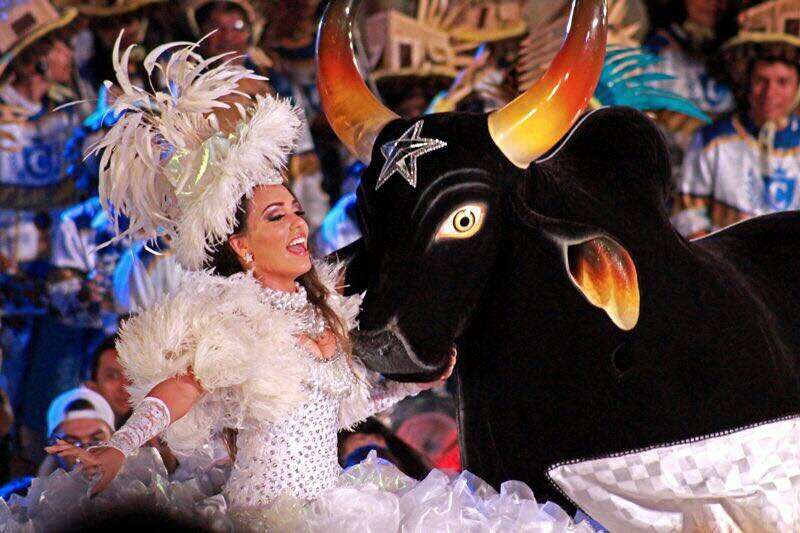 VALENTINA CID - Item 7 - Little Sinha of the Farm
VALENTINA CID - Item 7 - Little Sinha of the Farm
Daughter of the owner of the farm. The Boi-Bumbá Caprichoso goes back to the past to find the present and project its future. In Valentina Cid's veins runs the blue blood of the family which gave birth to the Boi de Parintins. The girl, who rehearsed her first steps at Boi Caprichoso's Art School, is Ednelza Cid's great-granddaughter, a seamstress, who for many years donated her time and a great part of her life to the Touro Negro de veludo making the most beautiful dresses for the sinhazinha and queens of the bull. Daughter of the eternal Sinhazinha, Karina Cid, the Boi Caprichoso is proud to keep the blood, the tradition and the history of the secular game alive by announcing Valentina Cid as the protector of the Boi Caprichoso, the new Sinhazinha of the Farm. The girl grew up in the Art School, went through dance and flute workshops, and was even a student in the modeling course that her mother Karina taught at the Boi Caprichoso Foundation.
Valentina has the opportunity to represent the simplicity of the same item that her mother defended. The owner of the Boi Caprichoso farm is a descendant of the first owner and founder of Caprichoso, Roque Cid. "Today my ox, my child's toy receives me as an item," says the beautiful Sinhá. The new Sinhazinha da Fazenda always dreamed of being an item of Caprichoso and is one more of the important fruits of the School of Art. "My desire to be an item was born in the School of Art, in the dance workshop, I was Queen of the Folklore of the Boi Caprichoso Mirim and today I am in love with being Sinhazinha of the Caprichoso Farm," she said. Like all warriors from Parintinense, she always longed to be in the ranks of the Boi Caprichoso. Today, history embraces the Blue and White Nation, by recognizing one of the descendants of the founders of Caprichoso as the defender of item number 7.
These are merits for punctuation: Beauty, grace, resourcefulness, simplicity and joy.
Differentials and comparisons: Costume, movements, greeting the ox and the public, sympathy and charisma.
CLEISE SIMAS - Item 8 - Queen of Folklore
Power expressed by the representative of the popular manifestation. The night of September 21, 2018, in the Praça dos Bois, blue side, marked the coronation of Cleise Bentes Simas, of Palmares neighborhood origin, as Rainha do Boi Caprichoso. The new individual female item will debut at the 54th Parintins Folkloric Festival, on the nights of June 28, 29 and 30, in Caprichoso's 2019 Boi de Arena project "A Song of Hope for the Marthria Brasilis." A fan since childhood, Cleise Simas began her dance trajectory in the Caprichoso's indigenous tribes in the Bumbódromo arena, still in her teens. In 2012, she joined the Corpo de Dança Caprichoso (CDC) and, in 2014, she became Rainha do Folclore, in the cast of Substitute Items, with the first performances in the Zeca Xibelão corral, in thematic rehearsals. Besides love, dedication, and passion, Cleise Simas has acquired experience, in official events of Boi Caprichoso, with the CDC or as a Substitute Item. The dancer made presentations in tourist shows, in Parintins, and trips, both nationally and internationally, with the cast of Boi Caprichoso. Cleise Simas also danced from Cunhã-Poranga as Substitute Item. All these years on stage have forged, polished, and perfected the dancer. To be the Queen of Folklore of Boi Caprichoso, for Cleise Simas, is the realization of a personal dream. The blue board of directors, through the president Babá Tupinambá, the vice-president Jender Lobato, and the coordinator of the Arts Council, bets in the talent of the dancer to take Caprichoso to the third championship.
They are merits for scoring: Beauty, sympathy, resourcefulness and embodiment.
Differentials and comparisons: Beauty, grace, movements, friendliness and attire.
 MARCIELE ALBUQUERQUE - Item 9 - Cunhã-Poranga
MARCIELE ALBUQUERQUE - Item 9 - Cunhã-Poranga
Beautiful girl, priestess, warrior and guardian, expresses strength through beauty. The Boi-Bumbá Caprichoso since the end of the 1980s, in a pioneering way marked by the toadas of Ronaldo Barbosa, raised the flag of resistance of the indigenous peoples. In the matrix of the formation of Brazil, some people that Caprichoso has evidenced in its shows, among them, Parintintintin, Tupinambá, Sateré-Mawé, Kaiapó, Karajá, Hexkariana, and Mundurukú, stand out. And it is from this last one that the Boi-Bumbá Caprichoso takes the item Cunhã-Poranga, the most beautiful of the village. The indigenous features, her dance, and the peculiar beauty of an Indian warrior give Marciele Albuquerque the headdress of Cunhã-Poranga.
The beautiful warrior has a degree in Administration and participates actively in the official events of the Boi Caprichoso, in Manaus, as the Boi Manaus. Marciele has already defended Boi Caprichoso as an official item in national and international events. In Parintins, she was substitute Cunhã-Poranga and dancer of the Caprichoso Dance Corps (CDC). "Being Cunhã-Poranga for me represents being the warrior woman, strong, who brings much more than beauty, but firmness in steps," said the most beautiful of the Caprichoso village. She asks for the support of the Blue and White Nation for the preparation period for the Folkloric Festival of Parintins. The new Cunhã-Poranga assures commitment to her item and the Boi Caprichoso. "I will dedicate myself 100% and I thank the support of the blue and white people," she highlights.
They are merits for scoring: Beauty, sympathy, resourcefulness and embodiment.
Differentials and comparisons: Beauty, grace, movements, friendliness and attire.
 ALEXANDRE AZEVEDO - Item 10 - Tripa do Boi [Boi-bumbá Evolution]
ALEXANDRE AZEVEDO - Item 10 - Tripa do Boi [Boi-bumbá Evolution]
Symbol of the popular manifestation, motive and reason for being of the festival. The plastic artist Alexandre Simas Azevedo inherited from his father the gift of giving life to the ox of cloth and is now prepared to defend the item tripa do Caprichoso. He grew up on Cordovil Street, traditional cradle of Caprichoso, and since childhood the boi-bumbá has been his favorite toy. It was at the age of 19 that Alexandre Azevedo danced for the first time under the star on his forehead, in an official Caprichoso event, in Brasilia, when his father, Marcos Azevedo, suffered an accident and could not travel. Since the year 2001, this relationship became closer with the star bumbá and he accompanied his father in the presentations in the Parintins Folkloric Festival until the time came to take over the item in October 2016.
The experience in the arena of the Bumbódromo and in official events of the Bumbá throughout Brazil allowed him to be his father's successor: "In 2001, Dad injured his foot in a street performance and the next day he had a trip to Brasília, a presentation for Coca-Cola and there was no one to go," he recalls. At that moment, in which the Caprichoso would be defalcated, the young Alexandre Azevedo took responsibility for himself and made himself available to the Caprichoso for the trip and thus began to accompany his father in the arena, in some moments, took turns in the item, either in the Bumbódromo, trips around the country and shows in Manaus. The first contact with the bull was when he was still a child. "As a child, I used to watch dad making the ox and I also used to play with a 'boizinho' on the street at home that competed with another ox from the other street," he recalls.
These are merits for punctuation: Evolution, staging and joy.
Differentials and comparisons: Identical geometry, lightness, choreography and movements of a real ox.
Healer, hierophant, shaman, priest, tribal point of equilibrium. Plastic artist, costume designer and dancer. Although young, the parintinense Netto Simões, from very early dedicated part of his life to art and dance, key elements that made him the new pajé of Boi Caprichoso. Living on Rua Sá Peixoto and always present at the rehearsals and events at Curral Zeca Xibelão, Neto Simões developed the gift of art when he made the clothing of the item pajé, from the Festival dos Bois em Miniatura, for more than 10 years. The contact with the characteristics of the item made him dedicate himself even more for the work, until he was invited to be the pajé in the Festival of Nova Maracanã, district of Faro, in 2009. His talent and good performance also led to an invitation to be a pajé at the Boi Espalha Emoção, one of the Bumbás at the Mocambo Folkloric Festival, in the rural area of Parintins, in 2011. From 2012 to 2013, Neto Simões was a substitute pajé for Boi Caprichoso and represented the item at the international environmental event, Rio+20, in Rio de Janeiro.
Through the president Babá Tupinambá, he assumed the position that was held by Waldir Santana for 30 years. The responsibility and commitment of being the newest item were embraced by Neto Simões, who received the new mission, focused on innovating and surprising the blue and white nation, to be a winner. Neto is a resident of Rua Sá Peixoto and is also part of one of the traditional families in Boi Caprichoso. He is currently studying History at the Amazonas State University (UEA).
They are merits for scoring: Body and facial expression, harmonic movements, mastery of scenic space.
Differentials and comparisons: Costume, originality, expression, safety, arena mastery, staging and choreography.
 Agile Manaus tourism and culture of Amazonas
Agile Manaus tourism and culture of Amazonas
